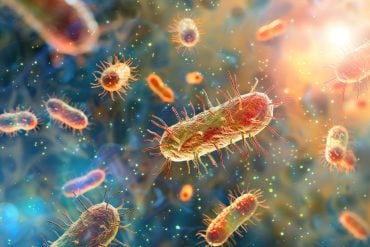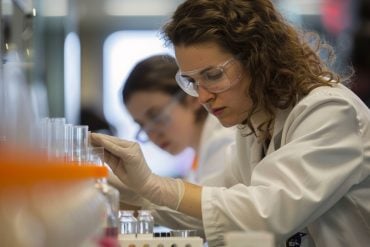Summary: Researchers discovered the link between autism and maternal infection does not appear to be causal. Results suggest the increased autism risks are more likely to be explained by shared familial factors including genetics or aspects of a shared environment.
Source:Karolinska Institute
Infections in pregnant women have been linked to an increased risk of neurodevelopmental conditions, such as autism, in the child later in life. But it does not seem to be the infections themselves that cause autism, researchers from Karolinska Institutet in Sweden show in a study published in The Lancet Psychiatry.
“Our results can reassure expectant parents by indicating that infections during pregnancy may not pose as great a risk to the baby’s brain as previously thought,” says Håkan Karlsson, researcher at the Department of Neuroscience at Karolinska Institutet and the study’s senior author.
Previous studies have shown a link between infections in the expectant mother during pregnancy and an increased risk of neurodevelopmental conditions, such as autism or intellectual disability, in the child later in life.
But they have not been able to say whether the mother’s exposure to infection is truly the cause, or whether other factors are behind this link. Researchers from Karolinska Institutet have now studied this in more detail.
The current study is based on data on more than 500,000 children born between 1987 and 2010. The aim was to investigate whether there is a causal relationship between infections in the woman during pregnancy and autism or intellectual disability in the child. Infections were included if they were severe enough to require specialist care and they were identified using diagnostic codes from patient and birth records.
Similar to previous studies, the researchers could see that infections that required specialist care during pregnancy were linked to an increased risk of autism and intellectual disability in children.
But when the researchers studied siblings, the result was different. In comparisons between sibling pairs where the mother had had an infection during one pregnancy but not the other, they could not find any link between infection and the children’s risk of autism. For intellectual disability, the link was weaker when the researchers compared sibling pairs than when they compared children who are not related.
The researchers also examined the risk of autism and intellectual disability in children if their mother had been diagnosed with an infection during the year before her pregnancy. The idea was that infection before pregnancy would not be linked to an increased risk of autism and intellectual disability if it really was the infection during pregnancy causing the neuropsychiatric conditions.
Here, the researchers could see that infections during the year before pregnancy were linked to the risk of autism to the same degree as infections during pregnancy, but not linked to the risk of intellectual disability.
“The link between infections in pregnant women and the increased risk of autism in their children does not appear to be causal.

“Our results suggest that the increase in risk is more likely to be explained by factors common between family members, such as genetic variation or certain aspects of the shared environment,” says Martin Brynge, Ph.D. student at the Department of Global Public Health, Karolinska Institutet, and one of the study’s two first authors.
Since the results were less clear for intellectual disability, it cannot be ruled out that infections during pregnancy may affect children’s risk for this condition.
In any case, infections during pregnancy may not influence the risk of intellectual disability to the same extent as previously thought, according to the researchers.
The researchers emphasize that they have only looked at diagnosis of infections in general. The study does not contradict the significance of the well-established links between some specific viral infections during pregnancy, such as cytomegalovirus infection and rubella, and the risk of serious developmental conditions in the child.
The researchers also point out that infections by the agent causing COVID-19 were not included in their study. It is still critical for pregnant women to follow their midwife’s advice regarding infection control.
About this ASD research news
Author: Press Office
Source: Karolinska Institute
Contact: Press Office – Karolinska Institute
Image: The image is in the public domain
Original Research: Open access.
“Maternal infection during pregnancy and likelihood of autism and intellectual disability in children in Sweden: a negative control and sibling comparison cohort study” by Håkan Karlsson et al. Lancet Psychiatry
Abstract
Maternal infection during pregnancy and likelihood of autism and intellectual disability in children in Sweden: a negative control and sibling comparison cohort study
Background
Maternal infections during pregnancy are associated with intellectual disability and autism in exposed children. Whether these associations are causal, and therefore should be targets of preventive strategies, remains unknown. We aimed to investigate these associations, to determine whether there is a causal role of maternal infection during pregnancy for children’s risk of autism and intellectual disability, by accounting for unmeasured familial factors.
Methods
We used a register-based cohort study design, and included children living in Stockholm County, Sweden, who were born in 1987–2010. We excluded children not born in Sweden, adopted children, and children with unknown biological mothers or fathers. Maternal infections during pregnancy, defined by ICD-8, ICD-9, and ICD-10 codes, were identified in the National Patient Register and Medical Birth Register. Children were followed up from birth to an outcome or a censoring event (death, migration from Stockholm, age 18 years, or Dec 31, 2016, whichever occurred first).
The primary outcomes were diagnosis of autism or diagnosis of intellectual disability. We did a survival analysis to examine the association between inpatient and outpatient specialised care for any infection during pregnancy and likelihood of autism or intellectual disability in the child. To address potential residual confounding, we also estimated the relationship between maternal infection in the year preceding pregnancy as a negative control exposure and conducted a matched sibling analysis of sibling pairs who were discordant for autism or intellectual disability.
Findings
647 947 children living in Stockholm County were identified and, after excluding 97 980 children, we included 549 967 in the study (267 995 [48·7%] were female and 281 972 [51·3%] were male; mean age at censoring 13·5 years [SD 5·0; range <1 to 18]; 142 597 [25·9%] had a mother who was not born in Sweden). 445 (1·3%) of 34 013 children exposed to maternal infection during pregnancy were diagnosed with intellectual disability and 1123 (3·3%) with autism. 5087 (1·0%) of 515 954 unexposed children were diagnosed with intellectual disability and 13 035 (2·5%) with autism. Maternal infection during pregnancy was associated with autism (hazard ratio [HR] 1·16, 95% CI 1·09–1·23) and intellectual disability (1·37, 1·23–1·51) in exposed children compared with unexposed children.
Maternal infection in the year before pregnancy (negative control exposure) was also associated with autism (HR 1·25, 95% CI 1·14–1·36), but was not associated with intellectual disability (1·09, 0·94–1·27). In sibling comparisons, the associations with maternal infection during pregnancy were attenuated for autism (HR 0·94, 95% CI 0·82–1·08; n=21 864), but not to the same extent for intellectual disability (1·15, 0·95–1·40; n=9275).
Interpretation
Although infections in pregnant women are associated with both autism and intellectual disability in their children, the association with autism does not appear to reflect a causal relationship, but is more likely to be explained by factors shared between family members such as genetic variation or aspects of the shared environment. Thus, infection prevention is not expected to reduce autism incidence. For intellectual disability, unmeasured familial factors might not fully explain the observed associations, and a causal role of maternal infections cannot be excluded. Causal effects of specific but rare infections or infections not requiring health care contact cannot be excluded in either autism or intellectual disability.
Funding
Swedish Research Council, Stanley Medical Research Institute, and Autism Speaks.
Translation
For the Swedish translation of the abstract see Supplementary Materials section.






